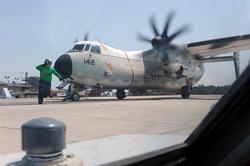- NAVAIR News |
- Photo Gallery |
- Videos |
- Acronyms |
- Public Affairs POCs |
- RSS
EMALS
The Electromagnetic Aircraft Launch System successfully completed the first launch of a C-2A Greyhound belonging to Air Test and Evaluation Squadron Two Zero (VX-20) from the NAVAIR Lakehurst, N.J., test site June 8. The Greyhound was launched 18 times over a wide range of aircraft weights June 8 and 9 as part of ongoing aircraft compatibility testing. EMALS, a complete launch system designed for Gerald R. Ford (CVN 78) and future Ford-class aircraft carriers will replace the steam catapult system which has been in use for more than 50 years. (U.S. Navy photo by Sherry Jacob)
An F/A-18E Super Hornet prepares to launch during a test of the Electromagnetic Aircraft Launch System (EMALS) at Naval Air Systems Command, Lakehurst, N.J. The Navy has used steam catapults for more than 50 years to launch aircraft from aircraft carriers. EMALS is a complete carrier-based launch system designed for Gerald R. Ford (CVN 78) and future Ford-class carriers. Newer, heavier and faster aircraft will result in launch energy requirements approaching the limits of the steam catapult, increasing maintenance on the system. The system's technology allows for a smooth acceleration at both high and low speeds, increasing the carrier's ability to launch aircraft in support of the warfighter. EMALS will provide the capability for launching all current and future carrier air wing platforms from lightweight unmanned aerial vehicles to heavy strike fighters. The first ship components are on schedule to be delivered to CVN 78 in 2011. (U.S. Navy photo/Released)
Engineers at Naval Air Systems Command, Lakehurst, N.J., continue work on the EMALS trough at the System Functional Display site. The combined testing culminates with the launch of dead-load weights and non-operational test aircraft at Naval Air Engineering Station Lakehurst, N.J. Commissioning with dead-loads is scheduled to begin fall 2009.” U.S. Navy Photo.
The Electromagnetic Aircraft Launch System is prepared to begin movement of the catapult’s shuttle Oct. 23 as the run out nears completion at Naval Air Systems Command, Lakehurst, N.J.














